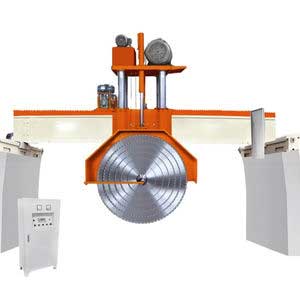Bridge Saw For Granite
 Granite is a popular natural stone used in the construction industry due to its durability, strength, and aesthetic appeal. However, cutting and shaping granite can be a challenging and time-consuming task, especially if done manually. That's where bridge saws for granite come in handy. In this article, we'll take a closer look at bridge saws for granite, their features, benefits, and how to choose the right one for your needs.
Granite is a popular natural stone used in the construction industry due to its durability, strength, and aesthetic appeal. However, cutting and shaping granite can be a challenging and time-consuming task, especially if done manually. That's where bridge saws for granite come in handy. In this article, we'll take a closer look at bridge saws for granite, their features, benefits, and how to choose the right one for your needs.
What is a Bridge Saw for Granite?
A bridge saw for granite is a specialized tool designed to cut and shape granite slabs into desired shapes and sizes. It consists of a stationary bridge-like structure that holds a diamond saw blade and a moving table that holds the granite slab. The saw blade moves along the bridge, cutting through the granite slab, while the table moves in the opposite direction, feeding the slab to the blade. Bridge saws for granite are controlled by a computer that ensures accuracy, precision, and consistency of the cuts.
Features and Benefits of Bridge Saw for Granite
Bridge saws for granite come with various features that make them efficient, reliable, and user-friendly. Some of the key features and benefits include:- High precision: Bridge saws for granite use computer-controlled systems that ensure precise and accurate cuts, reducing the risk of errors and waste.
- Efficient and fast: Bridge saws for granite are faster and more efficient than manual cutting methods, allowing you to cut multiple slabs in a shorter time frame.
- Versatile: Bridge saws for granite can cut granite slabs into different shapes and sizes, allowing you to create custom designs and patterns.
- Safety: Bridge saws for granite are equipped with safety features such as emergency stop buttons, automatic blade guard, and protective barriers that ensure safe operation.
- Cost-effective: Bridge saws for granite are cost-effective in the long run since they reduce labor costs and minimize material waste.
Types of Bridge Saw for Granite
There are several types of bridge saws for granite, and the choice will depend on your specific needs and budget. Here is a breakdown of the most common types:- Manual Bridge Saw for Granite: This type of saw requires manual operation, meaning that the operator must control the cutting process. Manual bridge saws for granite are less expensive than automatic saws and are suitable for small-scale operations. However, they are slower and less efficient than automatic saws.
- Automatic Bridge Saw for Granite: This type of saw is fully automated, meaning that the cutting process is controlled by a computer. Automatic bridge saws for granite are faster, more efficient, and suitable for large-scale operations. However, they are more expensive than manual saws and require skilled operators.
- Portable Bridge Saw for Granite: This type of saw is designed for on-site cutting and shaping of granite slabs. Portable bridge saws for granite are ideal for construction sites, outdoor installations, or projects with limited space. However, they are less powerful and less versatile than stationary saws.
How to Choose the Right Bridge Saw for Granite
Choosing the right bridge saw for granite can be a daunting task, especially if you're new to the industry. Here are some factors to consider when choosing a bridge saw:- Type: As mentioned earlier, you can choose between manual, automatic, or portable bridge saws depending on your needs, budget, and scale of operation.
- Blade size: The size of the saw blade determines the maximum size of the granite slab you can cut. If you're cutting larger slabs, you'll need a larger blade.
Request for Quotation
[contact-form-7 id="59" title="Contact form 1"]




